OLED vs Mini-LED: What’s the difference and is one actually better?
Is OLED vs Mini-LED display technology better?
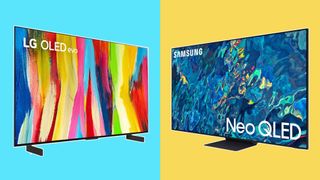
The best possible display technologies right now sees OLED vs Mini-LED in a quest of utter dominance and it's not one of simple this one's better than the other either. Both OLED and Mini-LED TVs have their pros and cons, making it hard to tell which is the better option.
One thing to note, however, that some of the best gaming TVs are OLEDs, it's a fact and it's truly hard to beat the clarity and general performance on these. Case in point is LG's newest entry in the LG C4 OLED, a powerhouse of a display that comes in a range of sizes.
But Mini-LED TVs have their improvements against OLEDs, namely better brightness potentials and far improved contrasts. Thus, you'll have to choose wisely when deciding between OLED and Mini-LED TVs, as even some of the best OLED TVs on the block don't always come equipped with great brightness.
And, PHOLEDs and QDEL TVs grow ever on the rise, brands like TCL are taking on OLEDs with QD-MIni-LED offerings, which it claims provide similar performance. With our years of testing TVs and knowhow in the space, we know just what the differences are and how best to steer you in your search for your next display.
OLED vs Mini-LED: What is OLED?
OLED stands for organic light-emitting diode, and it was first released in TVs in the United States in 2013. Until then, TV development was largely around refining the traditional LCD — but OLED flipped that on its head, as a totally new, totally different display technology.
That’s one of the keys to OLED technology — as it allows images with black to actually be black, since there’s no light in those areas of the image at all.
In OLED displays, each pixel contains an organic material that glows when you apply electricity to it. In fact, the more electricity you apply to the material, the more it glows – which also means that if you apply no electricity to it, it won’t illuminate at all. That’s one of the keys to OLED technology — as it allows images with black to actually be black, since there’s no light in those areas of the image at all.
OLED panels can also be flatter than other display panels because OLEDs can be applied directly to glass, and they don’t require a separate backlight.
Sign up to get the BEST of Tom's Guide direct to your inbox.
Get instant access to breaking news, the hottest reviews, great deals and helpful tips.
That said, it’s important to note that there are a few different ways in which OLED panels create color. Traditionally, many have simply used OLED technology as the backlight, shining through a color filter. Newer technologies are a little different though, instead use blue OLEDs combined with a layer of quantum dots to increase brightness. We’re not going to go into how that all works here — but we'll be sure to cover that in a future feature.
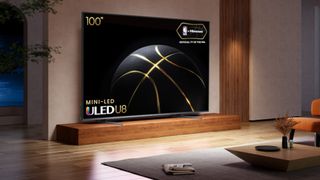
OLED vs Mini-LED: What is Mini-LED?
Mini-LED is a natural evolution of the traditional LED display. Typical LED displays work by using a backlight to illuminate an LCD panel. Each pixel in an LCD display contains three sub-pixels, which contain red, green, and blue (RBG) color filters, and can combine these sub-pixels to create separate colors.
The magic of a Mini-LED display, however, has more to do with the backlight than the LCD panel. Instead of one giant backlight, or a few dozen backlights, Mini-LED displays contain thousands of LED backlights, each of which measures between around 0.004 and 0.008 inches. The smaller size allows more LEDs to be packed together, and means that a TV can exert more control over the lighting, and turn off areas of an image that might contain black.
The LEDs in a Mini-LED display aren’t as small as those in a Micro-LED display — however Micro-LED technology is really only available on the most expensive TVs right now, while Mini-LED is much more mainstream.
OLED vs Mini-LED: Sharpness and resolution
The way we perceive the sharpness of a TV’s picture mostly has to do with its resolution — however before we get into the resolution of the TV technologies, it’s important to note that right now, the vast majority of content is available in resolutions up to 4K. Eventually, that will shift to 8K, but we’re not there yet.
It’s also important to mention that on a Mini-LED TV, the backlight is separate from the LCD pixels — so It’s possible to have a 1080p Mini-LED TV, or a 16K Mini-LED display, without the size of the backlight LEDs differing.
Right now, there’s little difference in the resolution of OLED and Mini-LED TVs. The vast majority of Mini-LED and OLED TVs have a 4K resolution. There are models with higher resolutions that leverage both of these technologies, but right now there aren’t really any limitations around the technologies and TV resolution.
Winner: Tie
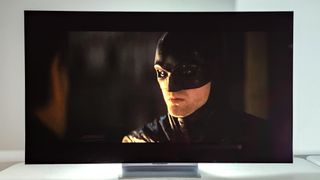
OLED vs Mini-LED: Black Levels
Black levels are one of the main areas of difference between these display technologies. As mentioned, Mini-LED TVs have thousands of tiny LEDs that are used in a backlighting system to illuminate the LCDs. That means they have much more control over black levels than previous-generation LCD TVs, and can provide deep blacks in certain scenarios.
However, even when an LED is switched off in a Mini-LED TV, the glow from the LEDs that are turned on around it can take away from what would otherwise be a true black — creating a kind of glowing effect around illuminated objects.
OLED TVs don’t have this issue. OLED TVs can create true blacks by simply not illuminating individual pixels, and don’t really have the issue of elevated blacks because the pixels are separated. While Micro-LED displays can approach this per-pixel control, Mini-LED displays aren’t quite there.
Winner: OLED
OLED vs Mini-LED: Brightness and contrast
Traditionally, brightness has been one area in which OLED TVs have suffered a little. That’s simply been a limitation of the technology — individual OLEDs just haven’t been able to get as bright as the LEDs that we use in the backlight of a Mini-LED display. In recent years, however, OLED TVs have been getting much brighter – however that’s largely through a new technology called QD-OLED that’s kind of separate from the OLED panels that most mainstream OLED TVs use right now. The brightest traditional OLED panels get to around 1,000 nits these days.
Mini-LED TVs, however, can get brighter. Mini-LED panels usually easily reach 1,500 nits, and often 2,000 nits or more (3,000 in the case of the Hisense U8N). Setting aside new QD-OLED panels, Mini-LED TVs can easily get brighter than OLED TVs.
Contrast is a slightly different conversation. Contrast ratio refers to the difference between the deepest blacks and the brightest whites. OLED TVs, as mentioned, can deliver deeper blacks — and in fact, can deliver so-called “true blacks.” This kind of breaks the concept of contrast a little, because the deepest blacks are infinite. So, technically, OLED TVs have a higher contrast ratio, but Mini-LED TVs can get brighter.
Winner: Mini-LED
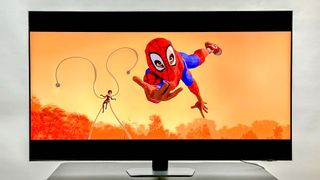
OLED vs Mini-LED: Color quality
When we talk about color quality, we’re usually talking about the range of colors a TV can produce, also known as the color gamut. The majority of mainstream TVs hit somewhere between 95% and 100% of the sRGB color spectrum, however top-end OLED TVs produce more than 100% of the SRGB color gamut. The Sony Bravia A95L OLED, for example, was able to cover 89% of the much broader Rec2020 color space in our tests last year.
Typical Mini-LED TVs don’t quite reach those heights — however keep in mind that has little to do with Mini-LED technology itself, which is a backlighting technology, and more to do with the kinds of color filters and layers that TV manufacturers use with Mini-LED backlights.
Winner: OLED
OLED vs Mini-LED: Viewing angles
Viewing angles of a TV refer to the ability for a TV to retain accurate colors when viewed off-center. This can be important — after all, only one person can truly watch a TV at its center, and if more than one person is watching, viewing angles can come into play.
Unless a TV manufacturer makes special accommodations, like the X-Wide Viewing Angle tech of the Sony X95L, LCD TVs typically have much narrower viewing angles than OLED ones. In comparison to most LCD TVs, though, OLED TVs have significantly wider viewing angles, meaning that large groups can enjoy watching a high-quality image. It's worth noting that the viewing angle of a Mini-LED TV has more to do with the type of display that’s used on top of the Mini-LED backlight, so be sure to check whether a TV uses a VA or IPS display.
Winner: OLED

OLED vs Mini-LED: Burn-in
One major issue that has plagued OLED TVs since the beginning is the issue of burn-in. Burn-in happens when a static image is displayed on a TV for extended periods of time. That doesn’t just relate to a photo on the screen, but, for example, could occur if you watch the same news station for hours on end, and find that the news station’s logo is always in the same spot. For the most part, issues around burn-in on OLED TVs have more or less been resolved at this point, through things like pixel shifting technology that detects static images and uses alternative pixels to display it.
Mini-LED TVs don’t really suffer from the same issues around burn-in. So, while the issue is mostly resolved on OLED TVs, it’s still more likely than on a Mini-LED TV.
Winner: Mini-LED
OLED vs Mini-LED: Size and price
Generally speaking, manufacturers have found it easier to build larger Mini-LED TVs than OLED TVs, however there are still some massive OLED TVs out there. LG, for example, makes a monster 97-inch LG G2 OLED TV — but you’ll have to pay $20,000 to get it.
There are more large Mini-LED TVs than OLED ones, and they're almost always cheaper. For example, you can get a similarly sized 98-inch TCL QM8 TV for around $5,000, or less when it’s on sale.
Why is that the case? OLED technology has been out for over 10 years now, but it’s still largely considered a premium TV technology. When Mini-LED TVs were first introduced, they were pretty expensive too — however the cost of the technology quickly fell, and generally, due to the lower cost of manufacturing, Mini-LED TVs can be bought at a lower price than OLED TVs.
Winner: Mini-LED
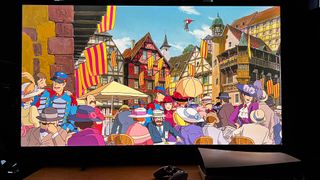
So which TV technology is best?
It might sound like a cop-out, but both are extremely good TV technologies. For the vast majority of people, Mini-LED is going to be the more tempting option as they can get brighter, don’t suffer from burn-in, and are cheaper. But dig in a little deeper, and you might find that an OLED TV is better for your needs. OLED TVs offer better viewing angles and produce slightly more natural colors and deeper black levels.
Setting brightness aside, OLED TVs are still considered a little more premium than Mini-LED TVs — and that will remain true as QD-OLED TVs like the Samsung S95C OLED continue to roll out, which solves issues around brightness.
In short, if you want an affordable TV at a larger screen size and with higher brightness levels, the Hisense U8K is probably the TV to go for. But if you want cinematic black levels with wider viewing angles and better color saturation, then the LG C3 OLED is a rival set that is definitely worth auditioning.
Both come highly recommended by the Tom's Guide staff.
Christian de Looper is a freelance writer who has covered every facet of consumer tech, including mobile, audio, home theater, computing, gaming, and even car tech. At Tom’s Guide, Christian covers TV and home theater tech, and has reviewed dozens of TVs, soundbars, and A/V receivers, including those from the likes of Samsung, Hisense, TCL, and Vizio.
- Ryan EppsStaff Writer
